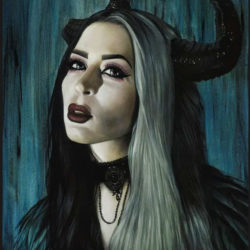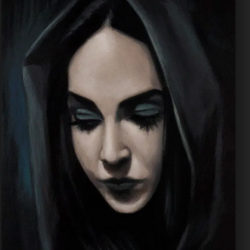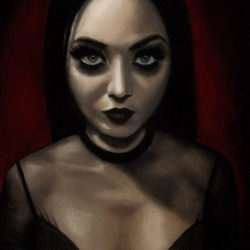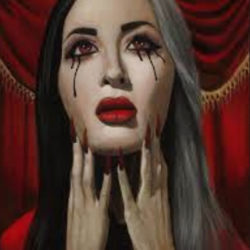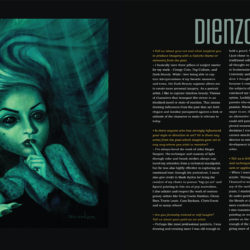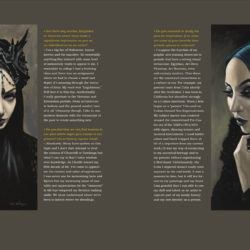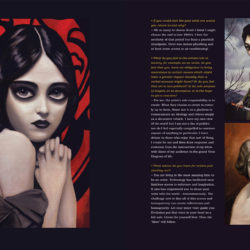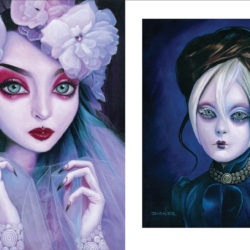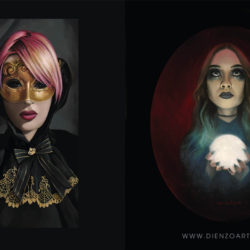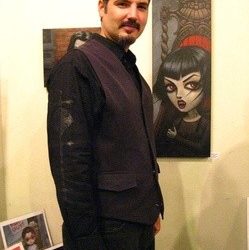Q: Tell us about your art and what inspired you to produce imagery with a historic theme or elements from the past.
A: I basically have three pillars of subject matter for my work – Creepy Cute, Pop Culture, and Dark Beauty. While I love being able to capture interpretations of my favorite monsters and icons, the Dark Beauty segment allows me to create more personal imagery. As a portrait artist, I like to capture timeless beauty.
Visions of characters that transport the viewer to an idealized mood or state of emotion. That means drawing influences from the past that are both elegant and familiar juxtaposed against a look or attitude of the character to make it relevant to today.
Q: Is there anyone who has strongly influenced your style or direction in art? Or is there any artist from the past which inspires your art in any way whom you wish to mention?
A: I’ve always loved the work of John Singer Sargent. His technique and mastery of light through color and brush strokes always captured my attention from a technical standpoint but he was also highly effective in capturing an emotional tone through his portraiture. I must also give credit to Mark Ryden for being the catalyst of my choice to pursue “big eye art” and figural painting in this era of pop surrealism. I also admire and respect the work of contemporary artists like Greg Craola Simkins, Glenn Barr, Travis Louie, Cam Rackam, Chris Guest and so many others!
Q: Are you formally trained or self taught? Tell us about your path as an artist.
A: Perhaps like most professional painters, I was drawing and creating since I was old enough to hold a pencil. We all got crayons as kids, I just chose to never let go of mine. I went to a traditional college prep high school where we all thought we were going to be doctors, lawyers or businessmen. I attended Loyola Marymount University and matriculated as a pre-med student. I thought I wanted to be a plastic surgeon because it combined science with art. However, the subjects of calculus and chemistry soon convinced me that “Dr, Blanco” was not an option. Luckily I had very loving and supportive parents who encouraged me to pursue my passion. When I said I wanted to change my major to art, they suggested Graphic Design as an alternative because I’d always find work and could still paint as well. It was one of those pivotal moments in my life and one of the best decisions I ever made. I ended up having two careers simultaneously. I work as a creative director in entertainment licensing / product development in addition to my work as a fine artist.
Q: Tell us a little about your preferred medium and technique, do you have any favorite products or applications?
A: When I started painting, I worked primarily in acrylic. Through my training as a graphic artist, I learned to work very flat and loved the immediacy of the medium. But as I’ve evolved over the years, I started working more with oils. I would do under paintings in acrylic and then “sweeten” the blends or do glazing in oil. Then as I became more comfortable, I now work entirely in oil. I also transitioned from painting on canvas to painting on wood or MDF. I’m not really a wet painter so the wood substrate tends to absorb enough of the paint to allow my blends but giving more of the response of pastel blending.
Q: Are there any stories, fairytales, or histories which have made a significant impression on you as an individual or as an artist?
A: I’m a big fan of Halloween, horror movies and the macabre. So essentially, anything that imbued with some level of melancholy tends to appeal to me. I remember in college I had a lettering class and there was an assignment where we had to choose a word and depict it’s meaning through the execution of form. My word was “Lugubrious.” Still love it to this day. Aesthetically I really gravitate to the Victorian and Edwardian periods. From architecture to fashion and the general somber tone of it all. Ultimately though, I like to mix modern elements with the vernacular of the past to create something new.
Q: Do you feel that we can find lessons in our past which might give reason to our present? (As in history repeats itself).
A: Absolutely. Many have spoken on this topic and I don’t dare attempt to rival the notions of Churchill or Hawkings but what I can say is that I value wisdom over knowledge. As I hurtle toward my fifth decade of life, I’ve come to appreciate the context and value of experiences. I was never one for memorizing facts and figures but my increasing sense of mortality and appreciation for the “moments” in life has tempered my decision making skills. We must understand where we’ve been to inform where we should go.
Q: Do you research or study the past for inspiration, if so what are some of your favorite time periods, places or cultures?
A: I suppose the function of my graphic arts training draws me to periods that have a strong visual vernacular. Egyptian, Art Deco, Victorian, Art Nouveau, even mid-century modern. Then there are the emotional connections to a culture or era. For example, my parents came from Cuba shortly after the revolution. I was born in California but identified strongly as a Cuban-American. When I first began as a “painter” I focused on Cuban-themed Neo-Expressionism. My subject matter was centered around the romanticized Pre-Castro era of the 1920’s/30’s/40’s with cigars, dancing women and musical instruments. I used bolder colors and black trapped lines. (A bit of a departure from my current work.) It was my way of connecting to my ancestral heritage and to my parents without experiencing it first-hand. Unfortunately, the Cuba I depicted doesn’t really exist anymore in the real world. It was a moment in time but it will live forever in my paintings and my heart. I am grateful that I was able to use my skill and talent as an artist to capture part of my family history and my own identity as a person.
Q: If you could visit the past what era would you return to and why?
A: Oh so many to choose from! I think I might choose the mid to late 1940’s. I love the aesthetic of that period but from a practical standpoint, there was indoor plumbing and at least some access to air conditioning!
Q: What do you feel is the artists role in society, for example, as an artist, do you feel that you have an obligation to bring awareness to certain issues which might have a greater impact visually than a verbal account might have? Or do you feel that art is non-political? Is its sole purpose to inspire, or be decorative, or is the hope to get a reaction?
A: For me, the artist’s sole responsibility is to create. What they choose to create is entirely up to them. Some use it as a platform to communicate an ideology and others simply as a decorative vehicle. I have my own view of the world but I am not a fan of politics nor do I feel especially compelled to convince anyone of anything in particular. I leave debate to those who enjoy that sort of thing. I create for me and then draw response and evolution from the intersection of my ideas with those of my audience in the grand Venn Diagram of life.
Q: What advice do you have for artists just starting out?
A: You are living in the most amazing time to be an artist. Technology has facilitated near limitless access to reference and inspiration. It also has empowered you to share your work with the world – instantaneously. The challenge now is that all of this access and transparency can create collectivism and homogeneity. Let your inner voice guide you. Evolution put that voice in your head as a fail-safe. Create for yourself first. Then the “likes” will follow.




